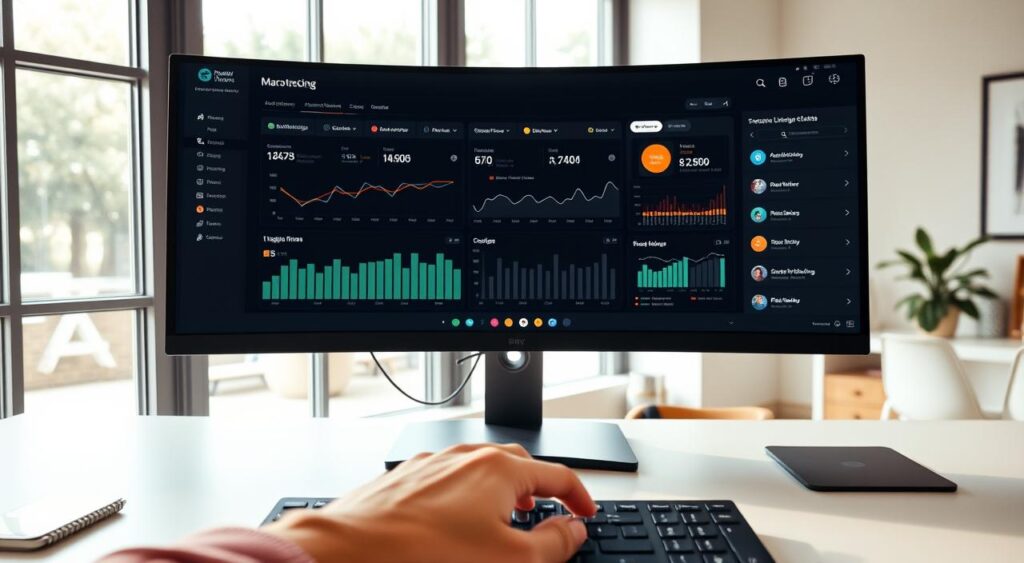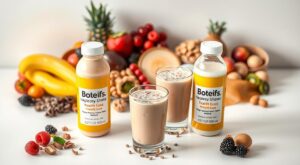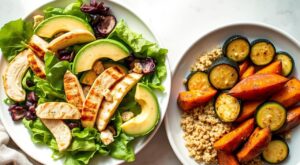Ever thought about enjoying your favorite foods and losing weight at the same time? Flexible dieting might be what you need. It’s a new way to eat called “If It Fits Your Macros” (IIFYM). This method focuses on tracking your macros—proteins, fats, and carbs—to make a diet that suits you.
This guide will show you how flexible dieting and tracking macros can help you lose fat and love food more. Learning to track your macros lets you eat flexibly while losing weight for good. Let’s explore how to make flexible dieting a part of your daily life.
Understanding Flexible Dieting
Flexible dieting, also known as IIFYM (If It Fits Your Macros), changes how we think about food. It’s about reaching your daily macronutrient goals, not just sticking to a list of foods. This way, you can enjoy treats without feeling guilty, making it easier to stick with for good.
What is Flexible Dieting?
Flexible dieting is all about balance and moderation. It lets you eat a wide range of foods while meeting your macronutrient needs. This approach makes dieting more flexible and fits better into your daily life.
Benefits of Flexible Dieting
Flexible dieting has many advantages. Studies show it helps people stick to their diet plans longer, which is key for keeping weight off. It also helps you feel less deprived, improving your mental health and how you view food. This method teaches you to appreciate nutrition without feeling overwhelmed by rules.
Common Misconceptions
Many myths surround dieting that can confuse those trying to lose weight. Some think flexible dieting means eating badly. But it’s actually about eating a balanced diet with some treats. It helps you develop healthy eating habits, avoiding the up-and-down cycles of dieting.
What Are Macros?
Understanding macronutrients is key for effective diet management. Macros include carbs, proteins, and fats. These nutrients are needed in large amounts for your body to work well. Each one has a special role in energy and metabolism.
Introduction to Macronutrients
Macronutrients are the base of your diet. Carbs make up 45–65% of your calories, with 4 calories per gram. Proteins, vital for muscle repair, are 10–35% of your calories, also with 4 calories per gram. Fats, with 9 calories per gram, make up 20–35% of your calories. A balanced mix of each is vital for health.
The Role of Protein, Fats, and Carbs
Proteins are key for muscle repair and growth. Fats are a rich energy source and help with vitamin absorption. Carbs are your main energy source for daily activities. Knowing their roles helps you balance your diet, meeting your energy needs and staying healthy.
Calculating Your Macros
To track your nutrition, start by calculating your macros based on your lifestyle and goals. First, find your Total Daily Energy Expenditure (TDEE). Then, set macro goals. Aim for 0.8-1 gram of protein per pound of body weight. Adjust carbs and fats based on your activity level. For more on flexible dieting and managing macros, check this resource.
How Macro Tracking Works
Learning to track your macronutrients can really help your dieting journey. With the right tools and methods, tracking macros becomes easy. This way, you can reach your health goals smoothly.
Tools for Tracking Macros
There are many tools to help you track macros accurately. These include:
- Food scales for precise weight measurements
- Measuring cups to portion out ingredients
- Online calculators designed for macro tracking
Each tool is important for keeping track and reaching your goals.
Apps You Can Use
Today, many apps make tracking food easy. Some top picks are:
- MyFitnessPal – Huge food database and easy to use
- Macro Tracker – Offers features for personal needs
- LoseIt – Helps set goals and offers community support
These apps help you stay on track. They also let you adjust portions and see your progress.
Creating a Personalized Macro Plan
Creating a macro plan that fits you is key. Think about your lifestyle, fitness goals, and what you like to eat. Use a macro calculator to make a plan that’s just right for you.
As you go along, feel free to change your plan. This will help you get the most out of your nutrition and wellness.

| App Name | Key Features | Best For |
|---|---|---|
| MyFitnessPal | Large database, barcode scanner, community | General tracking and accountability |
| Macro Tracker | Custom macros, detailed reports, reminders | Users needing personalized plans |
| LoseIt | Simplified logging, goal setting, challenge options | Goal-focused individuals |
The Science Behind Flexible Dieting
Flexible dieting is key in today’s nutrition world. It’s not just about counting calories. It’s about understanding how to stick to diets and why we make certain food choices. This approach lets you enjoy your favorite foods while staying healthy.
How Flexibility Affects Adherence
Being flexible in your diet makes it easier to stick to it. It lets you enjoy your favorite foods and fit into social plans. This way, you can enjoy your diet without feeling guilty, making it more sustainable.
The Psychology of Food Choices
Flexible dieting changes how we think about food. It helps us see food in a positive light, not as “good” or “bad.” This makes eating less stressful and helps us make better choices without guilt.
Research Supporting Macro Tracking
Studies show that tracking macros leads to better results. People who track macros lose weight faster than those on traditional diets. It teaches control and mindfulness, helping you succeed in the long run.

| Key Factors | Flexible Dieting | Traditional Dieting |
|---|---|---|
| Adherence Rate | Higher | Lower |
| Impact on Food Choices | Positive | Negative |
| Mindfulness in Eating | Enhanced | Limited |
| Weight Loss Achieved | Faster | Slower |
Setting Sustainable Goals
Setting sustainable weight goals is key for better health. It helps you create a path to success, blending physical and emotional well-being. Aim for both quick wins and long-term visions to keep moving forward.
Identifying Your Weight Goals
Start by setting clear weight goals. These could be losing, gaining, or keeping your current weight. Think about what’s realistic for you, based on your life and habits. Knowing why you want to achieve these goals helps you stay on track.
Remember, your goals should also improve your overall well-being. Emotional factors are just as important as physical ones in reaching your goals.
Balancing Short-Term vs. Long-Term Goals
It’s important to balance short-term and long-term goals. Short-term goals give you quick wins to keep you motivated. Long-term goals give you a bigger picture of your health journey.
Finding this balance helps you stay committed and flexible. It lets you adjust your approach as needed.
Adjusting Based on Progress
Keep track of your progress and be ready to make changes. If you hit a plateau, try adjusting your macros. Small tweaks can make a big difference.
Being open to changing your approach keeps you on the right path. It ensures you stay focused on your sustainable weight journey.

Meal Planning for Flexible Dieting
Effective meal planning is key to successful flexible dieting. By crafting meals that are not only nutritious but also enjoyable, you can foster a sustainable approach to food. This approach maintains variety and excitement. Understanding the importance of balanced meals will help you maximize your dietary goals and create delicious, healthy options.
Tips for Creating Balanced Meals
When engaging in meal planning, aim to include a source of protein, healthy fats, and complex carbohydrates in your dishes. A well-rounded meal ensures you receive the essential nutrients your body craves. Focus on creating colorful plates that are rich in diverse nutrients while satisfying your nutritional needs and taste preferences.
Incorporating Variety and Fun
Flexible dieting allows for creativity in the kitchen. Experiment with new foods and recipes to avoid monotony in your meals. Engaging in this culinary exploration keeps meal times enjoyable and motivates you to stick to your dietary goals. Share your flexible dieting meal ideas with friends or family to encourage a fun cooking experience together.
Sample Meal Ideas
Incorporate satisfying and nutrient-dense combinations into your daily meals. Consider dishes like grilled chicken with quinoa and steamed vegetables, which offer a perfect balance of flavor and nutrition. A smoothie made from spinach, banana, yogurt, and almond butter presents a quick and healthy option. For more creative meal options, check out flexible dieting meal ideas that elevate your meal planning game.

Overcoming Challenges in Macro Tracking
Tracking macros can be tough. Knowing the challenges helps you find ways to stay on track. This makes your journey easier and more enjoyable.
Dealing with Cravings
Cravings are a big challenge in macro tracking. They show you need something, whether it’s food or comfort. Knowing you can have treats in moderation helps avoid feeling left out.
Having small portions of your favorite foods can satisfy cravings. This way, you stay on track while enjoying what you love. It helps you have a healthier relationship with food.
Social Eating and Events
Social events can make tracking macros harder. Planning ahead helps a lot. Figure out your macros for the day before going out.
This lets you enjoy meals and treats without losing your way. Just be flexible and confident when eating out.
Staying Motivated
Keeping motivated is key to success in macro tracking. Check your goals often to see how far you’ve come. This keeps you focused and committed.
Having friends or groups who support your diet helps a lot. They offer encouragement and share your experiences. Tools like the macro split planner can also keep you motivated.
Integrating Flexible Dieting into Daily Life
Adding flexible dieting to your daily routine can change your life for the better. It needs planning, dedication, and a supportive circle. With teamwork and creativity, you can make this diet work for you.
Making it Work with Your Routine
To succeed, look at your schedule and figure out how to fit in your daily macros. Meal prep on weekends helps you stay on track during the week. With a plan, you can enjoy treats and meet your goals. Here are some helpful tips:
- Set up a meal prep schedule.
- Carry healthy snacks to work or school.
- Be flexible with your choices but stick to your macros.
Finding Support and Community
A strong support group is key for flexible dieting. Connecting with others who share your goals boosts your motivation. Online forums and local groups offer great advice, tips, and support. Joining these communities lets you:
- Share your journey and challenges.
- Celebrate your wins with others.
- Discover new recipes and ideas.
Staying Accountable to Yourself
Keeping yourself accountable is vital for flexible dieting success. Tracking your food helps you see your progress and areas to improve. Here are ways to boost your commitment:
- Use a food journal or app to track your macros.
- Set personal goals and reward yourself when you reach them.
- Reflect on your journey often to stay motivated.
The Benefits of Sustainable Weight Control
Sustainable weight control brings many benefits beyond just looking good. It helps you stay healthy for a long time, builds a strong mindset, and improves your relationship with food. Understanding these connections is key to achieving a balanced lifestyle.
Long-Term Health Impacts
By focusing on sustainable weight control, you can boost your metabolism and lower disease risks. Flexible dieting can also improve your mental health by reducing food anxiety. This approach helps you make choices that support your health goals.
Maintaining Weight Loss vs. Yo-Yo Dieting
Flexible dieting is different from strict diets that often lead to yo-yo dieting. It teaches you to adapt your weight management strategies as your life changes. This flexibility helps you keep weight off and stick to healthy habits for good.
Building Healthy Relationships with Food
Creating a sustainable weight control plan helps you connect with food in a real way. It moves you away from seeing food as “good” or “bad.” Emphasizing moderation helps reduce stress over food choices. This builds a positive attitude towards eating.
Exploring holistic diet approaches, like macro tracking, can lead to lasting health benefits. Check out effective dietary methods for sustainable weight control. They help avoid the cycle of yo-yo dieting.
Success Stories: Real-Life Examples
Many people have seen big changes in their lives thanks to flexible dieting. Their stories show how it can lead to amazing transformations. They prove you can reach your weight goals without feeling like you’re missing out.
Inspiring Transformations
There are countless stories of how flexible dieting has changed lives. People who felt stuck by old diet rules found freedom with macro tracking. They learned to enjoy many foods while staying healthy, improving their mental health too.
Testimonials from Flexible Dieters
Flexible dieters love sharing their joy of eating a wide variety of foods. They say they can have pizza or dessert without feeling guilty. Their stories help build a community that supports this way of eating.
Lessons Learned from the Journey
People on this journey often talk about the value of patience and kindness to oneself. They learn to know their limits and accept setbacks. These lessons show that success is a journey, not just a goal, making dieting more realistic.
| Aspect | Success Stories | Lessons Learned |
|---|---|---|
| Physical Changes | Weight loss and body composition improvements | Progress takes time and is unique to each person |
| Mental Health | Increased confidence and body acceptance | Emotional resilience helps overcome setbacks |
| Diet Experience | Enjoyment of various foods and reduced cravings | Learning to balance indulgence and nutrition |
Conclusion: The Future of Dieting
The world of weight loss is always changing. Now, we focus more on flexible diets that understand nutrition fully. These new ways of losing weight show that strict diets don’t work well in the long run.
Flexible dieting, like macro tracking, is leading the way. It helps you eat healthier without giving up your favorite foods. This makes it easier to stick to your diet and enjoy your meals.
Macro tracking is a smart choice for better health and enjoying your food. By using this method, you’re setting yourself up for lasting success. The future of dieting is all about being flexible and enjoying your life while eating well.














